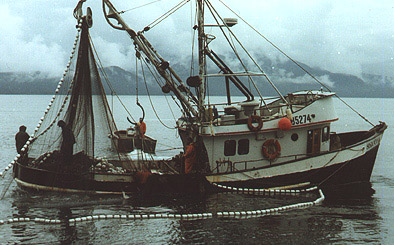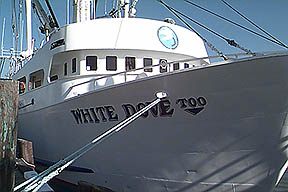| Purse seining
is a type of fishing in which a long rectangular net with a weighted bottom
edge and a buoyant top, floated by the cork line, is run around a school
of fish to contain it. As the above photo shows, a smaller boat is used
to control the free end of the net until the larger vessel comes around
to complete the encircling. At this point a line runs along the bottom
edge of the net is hauled in, forming the "purse" by closing of the bottom
of the net. This prevents the fish from escaping under the net and they
can't get over the floating cork line.
After the excess net is brough aboard, crowding
the fish into a smaller area, they are removed either by brailing - dipping
them out with large dip nets called brails - or with fish pumps.
Because such large nets are used, to the unintiated
purse seining generally appears to be an indiscriminate method of harvesting
fish. The characteristics of the species sought, however, as well as the
knowledge and experience of the fishermen make this an exceptionally clean
fishery.
The primary quarry quarry of purse seiners on
the East and Gulf coasts, the menhaden or mossbunker, is a densely schooling
fish that forms very compact masses in the water column. Net deployments
- called "sets" by the fishermen - on these dense schools contain few if
any other species. Periodically other fishermen, disturbed by what they
imagine to be large large numbers of non-targetted fish being killed, raise
a political ruckus to have what they mistakenly perceive as a "wasteful"
fishery stopped. Then the fisheries scientists dig out the old reports,
do some more sampling on the menhaden boats, prove yet again that it's
a clean fishery, and go back to their laboratories.
( for
an article on an anti-commercial harvesting campaign focusing on menhaden
purse seining in New Jersey) for
an article on an anti-commercial harvesting campaign focusing on menhaden
purse seining in New Jersey) |





